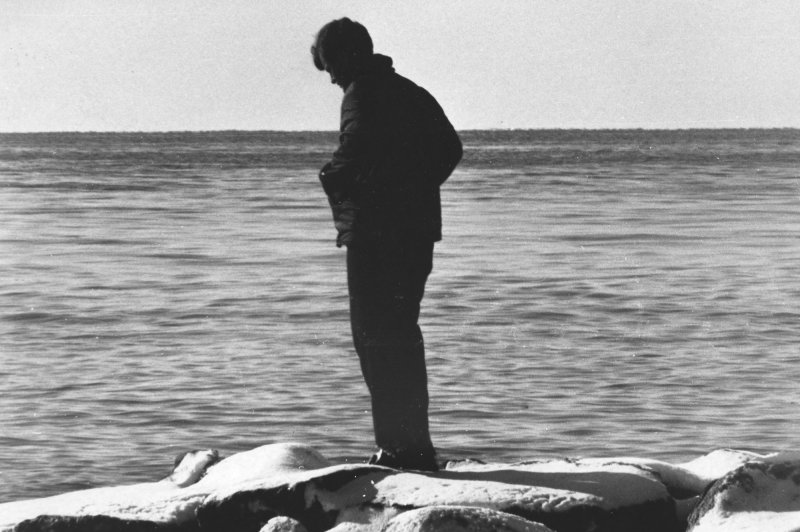1 of 5 | Sen. Edward M. Kennedy stands on a rocky beach in front of his Squaw island home on January 8, 1970, days after testifying at the inquest in Edgartown, Mass., into the death of Mary Jo Kopechne, who died when a car he was driving plunged off a bridge on Chappaquiddick Island. UPI Photo/File |
License Photo
July 18 (UPI) -- Fifty years ago this week, the world stood still as two astronauts became the first humans to step foot on the moon. But while history was being made away from Earth, Americans paid attention to headlines a little closer to home -- Sen. Edward Kennedy's involvement in a car crash that killed a woman on Chappaquiddick Island, Mass.
Kennedy was at the wheel of an Oldsmobile Delmont 88 when it went off the Dike bridge and into the Poucha Pond, killing 28-year-old Mary Jo Kopechne. The fatal crash and Kennedy's actions in the hours after it are likely what killed the Massachusetts senator's chances of ever being elected president.
The late-night crash happened July 18, 1969, two days before NASA astronauts Neil Armstrong and Buzz Aldrin captured headlines and television audiences as they walked on the moon. Kennedy and Kopechne were on the small island in Martha's Vineyard to attend a party made up mostly of women who worked on Robert F. Kennedy's 1968 presidential campaign. Several men who were friends of the women and the Kennedy family also attended.
Kennedy and Kopechne left the party together late in the evening, at which point the senator said he made a wrong turn onto the road heading toward the bridge and slammed on his brakes before plunging off the bridge into the water below.
"The car that I was driving, on an unlit road, went off a narrow bridge, which had no guardrails and was built on the left angle to the road. The car overturned in a deep pond, and immediately filled with water. I remember thinking as the cold water rushed in around my head that I was drowning," Kennedy said at a news conference a week after the accident.
Kennedy later told police he was able to pull himself free of the sinking car, but could not rescue Kopechne from the water's depths.
It's Kennedy's actions after the plunge that came under the most scrutiny in the days and years that followed. He told police he tried to help Kopechne, but, unable to free her, he said he walked back to the cabin where the party was held to seek help from his cousin, Joseph Garage, and U.S. Attorney Paul Markham.
Again, unable to remove Kopechne from the vehicle, Kennedy returned to Edgartown on Martha's Vineyard and failed to report the crash to police until the following morning.
"My conduct in conversations during the next several hours, to the extent that I can remember then, make no sense to me at all," he said. "I regard as indefensible the fact that I did not report the accident to the police immediately."
News of the incident didn't start hitting newspapers until the same day most news outlets were devoting most of their entire front pages to the moonwalk.
Kennedy eventually pleaded guilty to one count of leaving the scene of an accident causing personal injury and received a two-month suspended jail sentence. He would go on to have a 47-year career in the U.S. Senate, but his reputation never recovered enough to put a second Kennedy in the White House. An attempted challenge to incumbent President Jimmy Carter in 1980 failed and would be the only time Kennedy ran for the presidency. He died in 2009.
Residents of Chappaquiddick said the intense media attention on the crash changed the feel of the island community after that summer. Steven Ewing, a teenage deckhand on the ferry to the island that summer, told the Providence Journal that the next summer brought intense tourist interest to Chappaquiddick.
"It's a must-see. People still come from all over to see the Dike Bridge," the now-66-year-old said.
There was an uptick in tourism on the island and Martha's Vineyard in the 1970s that many locals attributed to the crash.
"Nobody had any money on Martha's Vineyard, it was a very poor community," Ewing said. But now, "local people can't afford to live here anymore."
The Martha's Vineyard Times said that in 1969, Chappaquiddick wasn't on anyone's radar.
Margaret Knight, who grew up on the island in the 1950s and 60s, told the newspaper that the island didn't have many services at the time and residents had to travel to the main island of Martha's Vineyard to go to church or the store.
"We were free to live life amidst the poison ivy and mosquitoes, without the prying eyes of officialdom," she said.















